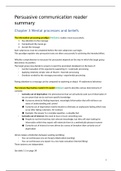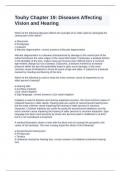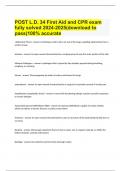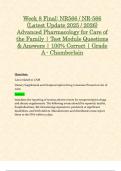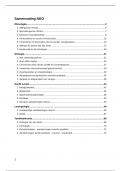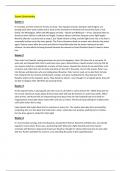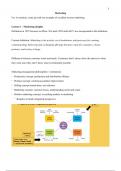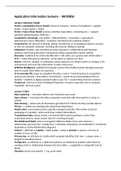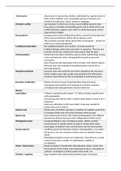Attachment
Introduction to attachment:
Attachment Attachment:
- Close two-way emotional bond between two individuals – seeing the other person
as essential for emotional security.
Caregiver-infant Babies have meaningful social interactions with their carers and these interactions are
interactions important for child social development and the development of caregiver-infant
interactions.
Reciprocity:
- How two people interact – mother and infant respond to each other’s signals and
elicit a response from the other.
- Babies have alert phases to signal readiness for interaction, mothers can pick up
on this and respond to the infant (Feldman & Eidelman, 2007).
- Becomes more frequent as the infant reaches 3-months-old – paying attention to
each other’s facial expressions and verbal signals (Feldman, 2007).
- Both mother and child can initiate these interactions, taking turns.
o Brazelton et al., (1975) – this interaction is like a ‘dance’ = each partner
responds to the other’s moves – used videotapes of 12 mother-baby pairs
while playing up to 5 months of age. Three stages of play: attention/build-
up, recovery and turning away. These three phases were repeated at
regular intervals over the 7-minute footage and they show signs of
organised behaviour early on in interactions.
Interactional synchrony:
- Mother and infant reflect both the actions and emotions of the other in a co-
ordinated/synchronised way.
o Mirror the actions and emotions of the other.
- Meltzoff and Moore (1977) – observed the beginnings of interactions synchrony in
infants as young as 2-weeks-old. Adult displayed one of three facial expressions or
distinctive gestures – filmed child’s response and had independent observers
identify the actions. Association was found between the expression/gesture the
adult had performed and the actions of the baby.
- Isabella et al., (1989) – observed 30 mothers and their infants, assessing the
degree of synchrony and quality of mother-infant attachment. Found that high
levels of synchrony was associated with better quality mother-infant attachment.
Evaluation: Controlled observations = capture fine detail:
caregiver-infant - Often filming from multiple angles to ensure nothing is missed, recorded and
interactions analysed later and often by different observers to reduce bias. Babies are not
bothered about being observed or recorded = their responses are not changed
(however, mothers could be).
- High internal validity if controlled.
Hard to know what is happening when observing infants:
- What is being observed is merely hand movements and changes in expression –
difficult to be certain what is taking place from the infant’s perspective – e.g. was
is conscious or deliberate? Cannot know for certain the interaction has special
meaning.
, Observations do not tell us the purpose of synchrony or reciprocity:
- Feldman (2012) – synchrony describes human behaviours occurring at the same
and can be reliable observed, but this does not tell us its purpose/why it happens.
But other evidence suggests that it is important for the development of mother-
infant attachments, stress response, empathy, language and moral development.
Attachment Parent-infant attachment:
figures - Most research investigates mother-infant attachments.
- Schaffer and Emerson (1964) – majority of babies form primary attachments with
their mothers at around 7-months-old and within a few weeks/months, will form a
secondary attachment to other family members, particularly the father.
o 75% of infants studied formed a secondary attachment to the father by 18-
months-old (sign of attachment – protested when father walked away).
Role of father:
- Grossman (2002) – longitudinal study looking at the behaviour and relationship
quality of both parents with their infant (follow-up into teen years). Quality of
attachment with the mother was related to child attachments in adolescence
(suggesting paternal attachment was less important). but fathers’ quality of play
was related to the quality of adolescent attachments = different role in attachment
– more to do with play/stimulation than nurturing.
Fathers as primary carers:
- Evidence does suggest that when fathers take on the role of main caregiver, they
adopt behaviours associated with mothers.
- Field (1978) – filmed 4-month-old infants in face-to-face interactions with primary
caregiver mothers, secondary caregiver fathers and primary caregiver fathers.
Primary caregiver fathers = like mothers they spent more time smiling, imitating
and holding their infants than secondary caregiver fathers.
- Fathers can be nurturing and show similar levels of responsiveness – not related to
the gender of parent.
Socially sensitive research: working mothers:
- Research into mother-infant interactions shows how the lack of interactions could
disadvantage children which would suggest that mothers should not return to
work so soon or be separated from their infants. This restricts opportunities for
interactional synchrony, which is important, however, limits the mother’s ability to
work and earn for her family – fits into a ‘bad parent’ assumption that she cannot
be a working woman and care for her child.
Evaluation: Inconsistent findings on fathers:
attachment - Researchers are interested in different research questions. E.g. some into
figures secondary attachments and others on primary attachments. Studies into these
different attachments with fathers obtain different results – e.g. maternal role or
play role. Cannot easily answer the question of ‘what is the role of the father?’
Children without fathers are not different:
- If fathers have a distinct role then children who grow up without fathers would be
expected to have different behaviours and development, but this is simply not the
case.
- The father is important but children in single-sex (female) families do not develop
differently to those in heterosexual families or single households (McCallum &
Golombok, 2004).
, - Fathers secondary attachment role may not be important.
Why do not fathers become the primary attachment?
- May be a result of gender roles – women are expected to be more caring and
nurturing and males may not feel they should act that way with a child. Or the
result of female hormones (e.g. oestrogen) creating higher levels of nurturing in
women = biologically predisposed to be the primary attachment figure (Taylor et
al., 2000).
EXAM 2 marks:
QUESTIONS Explain what is meant by interactional synchrony.
Explain what is meant by reciprocity.
4 marks:
Outline research into caregiver-infant interactions.
Outline two features of interactions synchrony.
Outline one criticism of research into reciprocity.
Discuss one limitation of research into multiple attachments.
(AO2 question) Psychologists are often asked to advise parents about parenting issues and
child development. Ellen and Anya are considering adopting a baby, so they consult a
psychologist about the role and importance of a father in a child's development. They are
anxious to make sure their child is not disadvantaged by growing up without a father in a
same-sex parent family. Based on research into fathers, what might the psychologist tell
them about growing up without a father?
6 marks:
Outline the role of the father in attachment.
16 marks:
Describe and evaluate research into caregiver-infant interactions.
Describe and evaluate research into multiple attachments.
Schaffer’s stages of attachment:
Schaffer and Sample:
Emerson’s - 60 babies (31M, 29F)
(1964) study - All from Glasgow and skilled working-class families.
Procedure:
- Visited the babies and their mothers at home every month for the first year of life,
then a follow-up up 18 months.
- Mother asked questions about whether the baby protests during separation
(measure of separation anxiety) and how the infant responds to unfamiliar adults
(measure of stranger anxiety) – both of which can assess attachment.
Findings:
- Between 25-32 weeks, 50% of the babies showed separation anxiety towards a
particular adults (usually the mother) = showing a specific attachment with the
parent who is most interactive and sensitive to infant signals (not always about
who they spend most of their time with).
- By 40 weeks, 80% had a specific attachment and 30% showed signs of multiple
attachments (attachments to two or more people, after forming a specific
Introduction to attachment:
Attachment Attachment:
- Close two-way emotional bond between two individuals – seeing the other person
as essential for emotional security.
Caregiver-infant Babies have meaningful social interactions with their carers and these interactions are
interactions important for child social development and the development of caregiver-infant
interactions.
Reciprocity:
- How two people interact – mother and infant respond to each other’s signals and
elicit a response from the other.
- Babies have alert phases to signal readiness for interaction, mothers can pick up
on this and respond to the infant (Feldman & Eidelman, 2007).
- Becomes more frequent as the infant reaches 3-months-old – paying attention to
each other’s facial expressions and verbal signals (Feldman, 2007).
- Both mother and child can initiate these interactions, taking turns.
o Brazelton et al., (1975) – this interaction is like a ‘dance’ = each partner
responds to the other’s moves – used videotapes of 12 mother-baby pairs
while playing up to 5 months of age. Three stages of play: attention/build-
up, recovery and turning away. These three phases were repeated at
regular intervals over the 7-minute footage and they show signs of
organised behaviour early on in interactions.
Interactional synchrony:
- Mother and infant reflect both the actions and emotions of the other in a co-
ordinated/synchronised way.
o Mirror the actions and emotions of the other.
- Meltzoff and Moore (1977) – observed the beginnings of interactions synchrony in
infants as young as 2-weeks-old. Adult displayed one of three facial expressions or
distinctive gestures – filmed child’s response and had independent observers
identify the actions. Association was found between the expression/gesture the
adult had performed and the actions of the baby.
- Isabella et al., (1989) – observed 30 mothers and their infants, assessing the
degree of synchrony and quality of mother-infant attachment. Found that high
levels of synchrony was associated with better quality mother-infant attachment.
Evaluation: Controlled observations = capture fine detail:
caregiver-infant - Often filming from multiple angles to ensure nothing is missed, recorded and
interactions analysed later and often by different observers to reduce bias. Babies are not
bothered about being observed or recorded = their responses are not changed
(however, mothers could be).
- High internal validity if controlled.
Hard to know what is happening when observing infants:
- What is being observed is merely hand movements and changes in expression –
difficult to be certain what is taking place from the infant’s perspective – e.g. was
is conscious or deliberate? Cannot know for certain the interaction has special
meaning.
, Observations do not tell us the purpose of synchrony or reciprocity:
- Feldman (2012) – synchrony describes human behaviours occurring at the same
and can be reliable observed, but this does not tell us its purpose/why it happens.
But other evidence suggests that it is important for the development of mother-
infant attachments, stress response, empathy, language and moral development.
Attachment Parent-infant attachment:
figures - Most research investigates mother-infant attachments.
- Schaffer and Emerson (1964) – majority of babies form primary attachments with
their mothers at around 7-months-old and within a few weeks/months, will form a
secondary attachment to other family members, particularly the father.
o 75% of infants studied formed a secondary attachment to the father by 18-
months-old (sign of attachment – protested when father walked away).
Role of father:
- Grossman (2002) – longitudinal study looking at the behaviour and relationship
quality of both parents with their infant (follow-up into teen years). Quality of
attachment with the mother was related to child attachments in adolescence
(suggesting paternal attachment was less important). but fathers’ quality of play
was related to the quality of adolescent attachments = different role in attachment
– more to do with play/stimulation than nurturing.
Fathers as primary carers:
- Evidence does suggest that when fathers take on the role of main caregiver, they
adopt behaviours associated with mothers.
- Field (1978) – filmed 4-month-old infants in face-to-face interactions with primary
caregiver mothers, secondary caregiver fathers and primary caregiver fathers.
Primary caregiver fathers = like mothers they spent more time smiling, imitating
and holding their infants than secondary caregiver fathers.
- Fathers can be nurturing and show similar levels of responsiveness – not related to
the gender of parent.
Socially sensitive research: working mothers:
- Research into mother-infant interactions shows how the lack of interactions could
disadvantage children which would suggest that mothers should not return to
work so soon or be separated from their infants. This restricts opportunities for
interactional synchrony, which is important, however, limits the mother’s ability to
work and earn for her family – fits into a ‘bad parent’ assumption that she cannot
be a working woman and care for her child.
Evaluation: Inconsistent findings on fathers:
attachment - Researchers are interested in different research questions. E.g. some into
figures secondary attachments and others on primary attachments. Studies into these
different attachments with fathers obtain different results – e.g. maternal role or
play role. Cannot easily answer the question of ‘what is the role of the father?’
Children without fathers are not different:
- If fathers have a distinct role then children who grow up without fathers would be
expected to have different behaviours and development, but this is simply not the
case.
- The father is important but children in single-sex (female) families do not develop
differently to those in heterosexual families or single households (McCallum &
Golombok, 2004).
, - Fathers secondary attachment role may not be important.
Why do not fathers become the primary attachment?
- May be a result of gender roles – women are expected to be more caring and
nurturing and males may not feel they should act that way with a child. Or the
result of female hormones (e.g. oestrogen) creating higher levels of nurturing in
women = biologically predisposed to be the primary attachment figure (Taylor et
al., 2000).
EXAM 2 marks:
QUESTIONS Explain what is meant by interactional synchrony.
Explain what is meant by reciprocity.
4 marks:
Outline research into caregiver-infant interactions.
Outline two features of interactions synchrony.
Outline one criticism of research into reciprocity.
Discuss one limitation of research into multiple attachments.
(AO2 question) Psychologists are often asked to advise parents about parenting issues and
child development. Ellen and Anya are considering adopting a baby, so they consult a
psychologist about the role and importance of a father in a child's development. They are
anxious to make sure their child is not disadvantaged by growing up without a father in a
same-sex parent family. Based on research into fathers, what might the psychologist tell
them about growing up without a father?
6 marks:
Outline the role of the father in attachment.
16 marks:
Describe and evaluate research into caregiver-infant interactions.
Describe and evaluate research into multiple attachments.
Schaffer’s stages of attachment:
Schaffer and Sample:
Emerson’s - 60 babies (31M, 29F)
(1964) study - All from Glasgow and skilled working-class families.
Procedure:
- Visited the babies and their mothers at home every month for the first year of life,
then a follow-up up 18 months.
- Mother asked questions about whether the baby protests during separation
(measure of separation anxiety) and how the infant responds to unfamiliar adults
(measure of stranger anxiety) – both of which can assess attachment.
Findings:
- Between 25-32 weeks, 50% of the babies showed separation anxiety towards a
particular adults (usually the mother) = showing a specific attachment with the
parent who is most interactive and sensitive to infant signals (not always about
who they spend most of their time with).
- By 40 weeks, 80% had a specific attachment and 30% showed signs of multiple
attachments (attachments to two or more people, after forming a specific



